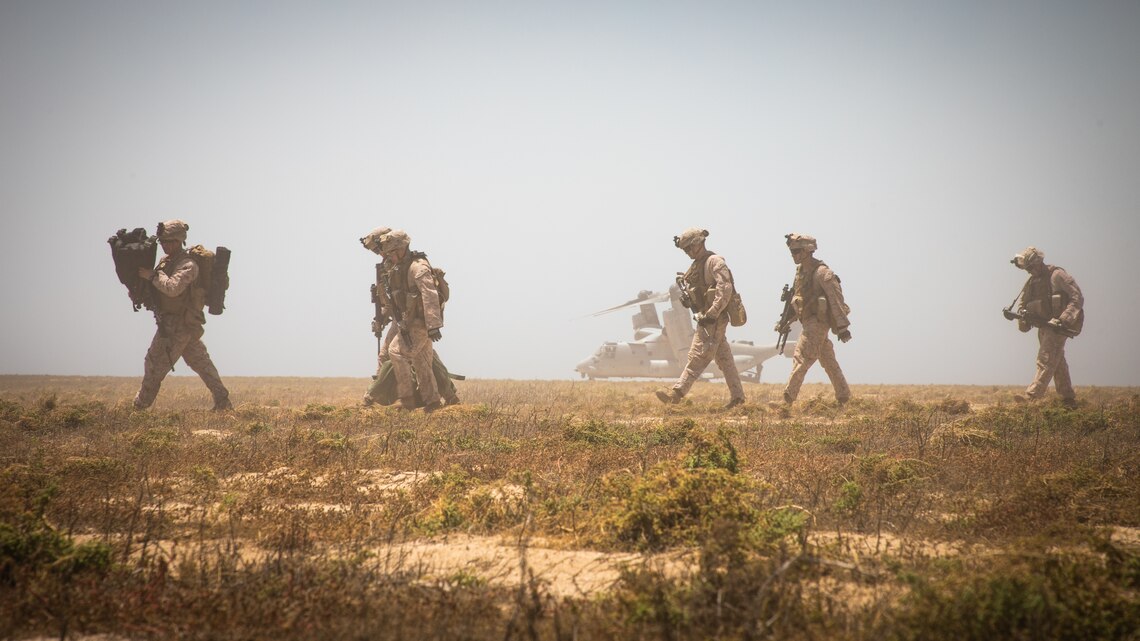
The 26th Marine Expeditionary Unit, embarked aboard the Bataan Amphibious Ready Group, conducted routine amphibious assault training on the islands of Karan and Kurayn, Saudi Arabia, April 20-22.
The training was preplanned and coordinated through the Kingdom of Saudi Arabia, and provided approximately 800 Marines and Sailors the opportunity to train in amphibious operations in a realistic environment.
Over the course of three days, the BATARG and 26th MEU planned and conducted a variety of the MEU’s mission-essential tasks including amphibious raids and amphibious assaults. Amphibious raids involve swift incursions and withdrawals, while amphibious assaults can result in occupation of an objective and preparing for follow-on operations.
“Through support in planning, establishing maritime dominance, executing ship-to-shore evolutions, and preparing for a simulated shipboard weapons shoot – the BATARG was able to receive valuable training and enable the success of the 26th MEU’s mission ashore,” said Lt. Cmdr. Grace Reilly, assistant operations officer with the BATARG.
The BATARG consists of the flagship amphibious assault ship USS Bataan (LHD 5), the amphibious transport dock ship USS New York (LPD 21) and the dock landing ship USS Oak Hill (LSD 51), and is supported by the guided-missile destroyer USS Stout (DDG 55).
The BATARG and 26th MEU team concurrently utilized air and surface assets to transport forces and equipment to the two islands. This capability is unique to the Amphibious Ready Group Marine Expeditionary Units and enhances versatility when conducting amphibious operations in the maritime domain. The MEU has an aviation combat element which is equipped with fixed-wing, rotary-wing and tilt-rotor aircraft capable of operating over land or over water alongside ship-to-shore connectors such as assault amphibious vehicles and other landing craft.
The integration of the Navy-Marine Corps team was an essential element of the sustainment training on the islands. As a cohesive team, the ARGMEU transported forces and firepower to Karan Island and facilitated fire support by utilizing artillery assets.
“The MRF provides the MEU a force that can deliver decisive victories that reduce enemy capabilities, induce confusion and create a gap to exploit with follow-on combat power.” Capt. Cory Moyer, company commander of the MRF
During this training, Marines with the Battalion Landing Team were flown to Kurayn Island and conducted a simulated raid, while other Marines executed an amphibious assault on Karan Island’s beach. The training on the two islands was invaluable to the MEU’s readiness as islands present unique challenges not usually encountered by ground-based units.
In preparation for training on the islands, reconnaissance Marines conducted hydrographic surveys under the cover of darkness, provided amphibious reconnaissance and surveillance, and maneuvered combat rubber raiding craft throughout the littoral region. The Maritime Raid Force is capable of controlling key maritime areas in time of conflict.
“The control of key maritime terrain requires specially-trained Marines,” said Capt. Cory Moyer, company commander for the MRF. “The MRF provides the MEU a force that can deliver decisive victories that reduce enemy capabilities, induce confusion and create a gap to exploit with follow-on combat power.”
Sourcing combat power ashore from a sea-based platform allows the ARGMEU to be flexible, expeditionary, and postured to shape actions across the full range of military operations in remote, marginally accessible, environments.
In conjunction with the BATARG and 26th MEU, The Special Purpose Marine Air-Ground Task Force – Crisis Response – Central Command 19.2 also conducted a full mission profile, tactical recovery of aircraft and personnel exercise on Karan and Kurayn Islands on April 23.
The preplanned exercise affords the SPMAGTF-CR-CC an opportunity to sustain and improve its critical mission capabilities, as well as demonstrate its ability to rapidly respond to emergent threats and crises.
“I extend my sincere appreciation to the Kingdom of Saudi Arabia for providing this unique and effective training opportunity for the Bataan Amphibious Ready Group, the 26th Marine Expeditionary Unit and Special Purpose Marine Air-Ground Task Force-Crisis Response-Central Command,” said Vice Admiral James Malloy, commander U.S. Naval Forces Central Command. “These training evolutions not only contribute to our readiness to respond to crisis but also demonstrate the Navy-Marine Corps team’s significant contribution in ensuring freedom of navigation, the free flow of commerce and lawful control of the maritime domain in the U.S. Central Command area of responsibility.”



